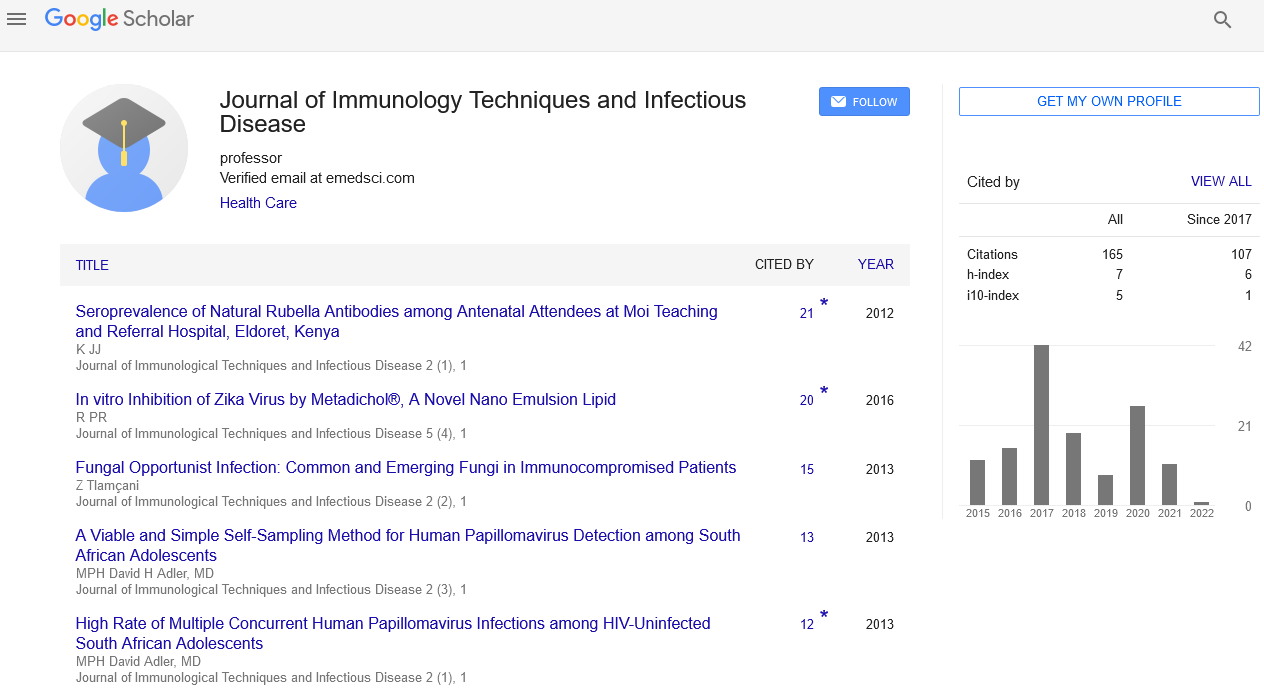Perspective, J Immunol Tech Infect Dis Vol: 12 Issue: 3
Interaction of Antigens with Specific Antibodies
Marta Kille*
1Department of Medicine, University of Chicago, Chicago, USA
*Corresponding Author: Marta Kille,
Department of Medicine, University of
Chicago, Chicago, USA
E-mail: marta.kille@gmail.com
Received date: 30 August, 2023, Manuscript No. JIDIT-23-116452;
Editor assigned date: 01 September, 2023, PreQC No. JIDIT-23-116452 (PQ);
Reviewed date: 15 September, 2023, QC No. JIDIT-23-116452;
Revised date: 22 September, 2023, Manuscript No. JIDIT-23-116452 (R);
Published date: 29 September, 2023, DOI: 10.4172/2329-9541.1000355.
Citation: Kille M (2023) Interaction of Antigens with Specific Antibodies. J Immunol Tech Infect Dis 12:3.
Description
The immune system is a remarkable and intricate defense mechanism that safeguards the body against harmful invaders, such as bacteria, viruses, and other pathogens. At the heart of this defense system is the incredible dance of recognition between antigens and specific antibodies. Antigens are molecules or molecular structures found on the surface of pathogens or foreign substances that enter the body. They are like the "identity badges" of invaders, allowing the immune system to distinguish between self (the body's own cells) and non-self (foreign entities). Antigens can include proteins, carbohydrates, and other molecules. Antibodies, also known as immunoglobulins, are Y-shaped proteins produced by specialized white blood cells called B cells. Each antibody is highly specific and designed to recognize a particular antigen. Think of antibodies as "lock and key" systems, where each antibody has a unique binding site that matches the shape of a specific antigen. The interaction between antigens and antibodies is an important step in the immune response.
When an antigen enters the body, the immune system's surveillance mechanisms detect it. This recognition can occur through various means, such as Antigen-Presenting Cells (APCs) signaling to other immune cells or direct detection by B cells. Once recognized, B cells specific to that antigen are activated. These B cells then undergo clonal selection, where they multiply rapidly to form a clone of identical B cells, all bearing the same antibody with the appropriate binding site. The activated B cells differentiate into plasma cells, which are specialized factories for producing antibodies. Each plasma cell churns out thousands of copies of the specific antibody needed to combat the invading antigen. Antibodies circulate in the bloodstream, lymphatic system, and tissues, waiting for their specific antigen to appear. When an antibody encounters its matching antigen, a binding event occurs. This is a highly precise interaction, akin to a key fitting into a lock. Once bound to the antigen, antibodies can neutralize the threat in various ways.
Antibodies can cover or block the antigen's active sites, preventing it from attaching to host cells. Antibodies can clump together pathogens, making them easier for immune cells to engulf and eliminate. Antibodies can trigger a series of immune responses, known as the complement cascade, leading to the destruction of the pathogen. Antibodies can bind to pathogens and enhance their recognition and ingestion by white blood cells, like macrophages. Some B cells, called memory B cells, are generated during the immune response. These cells "remember" the specific antigen and remain in circulation for years, providing long-term immunity. If the same antigen reappears in the future, memory B cells can rapidly produce antibodies to mount a faster and more effective immune response.
Importance in immunity
The interaction of antigens with specific antibodies is fundamental to the immune system's ability to defend against pathogens. Antibodies precisely target and neutralize specific pathogens, leaving the body's own cells unharmed. This high specificity ensures a tailored immune response. The immune system can produce an immense variety of different antibodies, each specific to a different antigen. This diversity allows it to combat a wide range of pathogens. The ability to generate memory B cells means that the immune system "learns" from previous encounters with pathogens.
Conclusion
The dance of recognition between antigens and specific antibodies is a marvel of biological precision. This essential process underpins the immune system's ability to identify and neutralize invaders, keeping us healthy and protected from a myriad of potential threats. The intricate interplay between antigens and antibodies is a testament to the remarkable complexity and effectiveness of our immune defenses, constantly working to maintain our well-being. This memory enables faster and more efficient responses upon subsequent exposures. Antibodies produced in response to vaccinations, for example, can provide long-lasting protection against diseases without the need for actual infection.
 Spanish
Spanish  Chinese
Chinese  Russian
Russian  German
German  French
French  Japanese
Japanese  Portuguese
Portuguese  Hindi
Hindi 
